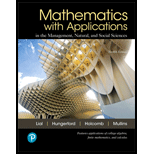
Whether the ordered pairs ( − 2 , 3 ) , ( 0 , − 5 ) , ( 2 , − 3 ) ( 3 , − 2 ) , ( 4 , 3 ) and ( 7 , 2 ) y = x 2 − 2 x − 5
Answer to Problem 1RE
Solution:
The ordered pairs
Explanation of Solution
Given:
The expression is
Explanation:
For
So, left hand side is equal to right hand side.
Therefore,
Now, for
So, left hand side is equal to right hand side.
Therefore,
Now, for
So, left hand side is not equal to right hand side.
Therefore,
Now, for
So, left hand side is equal to right hand side.
Therefore,
For
So, left hand side is equal to right hand side.
Therefore,
Now, for
So, left hand side is not equal to right hand side.
Therefore,
Want to see more full solutions like this?
Chapter 2 Solutions
Mathematics with Applications In the Management, Natural, and Social Sciences (12th Edition)
- 2. Alice has three unfair coins. The first coin shows heads with proba- bility 0.3 and tails with probability 0.7. The second coin shows heads with probability 0.9 and tails with probability 0.1. The third coin shows heads with probability 0.4 and tails with probability 0.6. First, Alice throws a dice. If the dice yields a 1 or 2, Alice tosses the first coin. If the dice yields a 3, Alice tosses the second coin. If the dice yields a 4 or 5, or 6, Alice tosses the third coin. (i) What is the probability of the following event: as a result of throwing the dice and then tossing a coin, tails appear. [7 Marks] Assume a coin shows tails. What is the probability that Alice (ii) tossed (a) the first coin; (b) the second coin; Total marks 11 (c) the third coin? [4 Marks]arrow_forwardPlease could you check if my answers are correctarrow_forwardA project schedule has the following characteristics as shown in Table Activity Name Time Activity Name Time (days) 1-2 A 4 5-6 G 4 1-3 B 1 5-7 H 8 2-4 C 1 6-8 I 1 3-4 D 1 7-8 J 2 3-5 E 6 8-10 K 5 4-9 F 5 9-10 L 7 i. Construct PERT network. ii. Compute TE and TL for each activity. iii. Find the critical path.arrow_forward
- Determine if the the collection is graphical. If not, explain why; if true. draw a graph associated with the collection. (a) {0, 1, 2, 3}. (b) {2,2,3,3}. (c) {2,2,2,3}.arrow_forward13. Let (X,<) be a partially ordered set, and let X 0. Indicate the condition that guarantees the existence of a maximal element in (X, <): a. (X,) is a linearly ordered set. b. X is a finite set, or every linearly ordered subset of X has an upper bound. c. (X,) is a well-ordered set. d. There exists a minimal element in (X, ≤).arrow_forward0 Let A = Use mathematical induction to show that An == [ 10 n 1 for all n≥1arrow_forward
- Exercise 14.4. Let R be a ring, and Z(R) = {a Є R | ab = ba, \b € R} For every nЄN, show that Z(Mn(R)) = - {( - ) \ - - x m} a Z(R)arrow_forwardA region is bounded by y = 0, y = x³, and x = 1. Find the x coordinate of the center of mass. Round off to two decimal places. Remember if A is the area of the region then 1 x = ffxdydx Aarrow_forwardConsider a simplified two-joint robotic arm where the two joints are connected by rigid links.Each joint has a mass, and the links are modeled as idealized rods. The motion of each jointaffects the other through the coupling of forces. The system can be modeled by the followingsecond-order coupled ODEs: m1 ̈θ1 + k1(θ1 − θrest) + k3(θ1 − θ2) = 0 (equation 1)m2 ̈θ2 + k2(θ2 − θrest) + k3(θ2 − θ1) = 0 (equation 2) where θ1(t) and θ2(t) represent the angular positions of the first and second joints, respec-tively. m1 and m2 are the effective masses at each joint. k1, k2 and k3 are the stiffnessconstants representing the elastic restoring forces in the joints and links. θrest = 0 representsthe equilibrium position for each joint.The parameters are:m1 = 1, m2 = 1, θrest = 0, k1 = 1, k2 = 2, k3 = 3, θrest = 0The initial conditions are:θ1(0) = 1, θ2(0) = 2Please solve by hand using eigenvectors and eigenvalues. Show all steps/calculations, and provide a written description of each step. Then do…arrow_forward
- : G → Exercise 14.5. Let G be a group and R be a ring. Show that every group homomorphism R* can be uniquely extended to a ring homomorphism & : Z[G] → R satisfying that (g) = (g) for every g € G.arrow_forwardy=ln((1+e^x)/(1-e^x)) find the derivative.arrow_forwardsolve it via excel solverarrow_forward
 Discrete Mathematics and Its Applications ( 8th I...MathISBN:9781259676512Author:Kenneth H RosenPublisher:McGraw-Hill Education
Discrete Mathematics and Its Applications ( 8th I...MathISBN:9781259676512Author:Kenneth H RosenPublisher:McGraw-Hill Education Mathematics for Elementary Teachers with Activiti...MathISBN:9780134392790Author:Beckmann, SybillaPublisher:PEARSON
Mathematics for Elementary Teachers with Activiti...MathISBN:9780134392790Author:Beckmann, SybillaPublisher:PEARSON
 Thinking Mathematically (7th Edition)MathISBN:9780134683713Author:Robert F. BlitzerPublisher:PEARSON
Thinking Mathematically (7th Edition)MathISBN:9780134683713Author:Robert F. BlitzerPublisher:PEARSON Discrete Mathematics With ApplicationsMathISBN:9781337694193Author:EPP, Susanna S.Publisher:Cengage Learning,
Discrete Mathematics With ApplicationsMathISBN:9781337694193Author:EPP, Susanna S.Publisher:Cengage Learning, Pathways To Math Literacy (looseleaf)MathISBN:9781259985607Author:David Sobecki Professor, Brian A. MercerPublisher:McGraw-Hill Education
Pathways To Math Literacy (looseleaf)MathISBN:9781259985607Author:David Sobecki Professor, Brian A. MercerPublisher:McGraw-Hill Education





